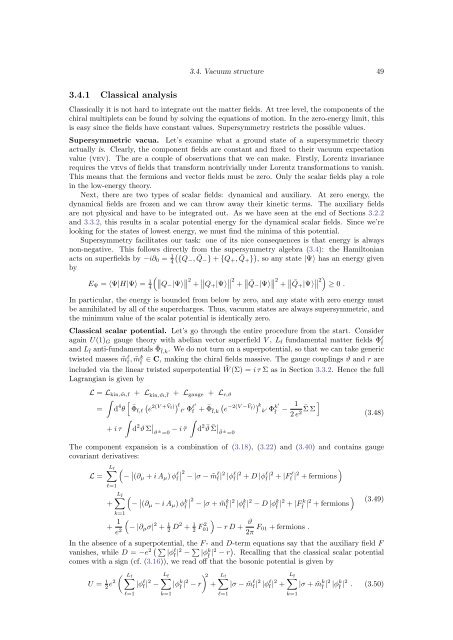The Bethe/Gauge Correspondence
The Bethe/Gauge Correspondence
The Bethe/Gauge Correspondence
You also want an ePaper? Increase the reach of your titles
YUMPU automatically turns print PDFs into web optimized ePapers that Google loves.
3.4. Vacuum structure 493.4.1 Classical analysisClassically it is not hard to integrate out the matter fields. At tree level, the components of thechiral multiplets can be found by solving the equations of motion. In the zero-energy limit, thisis easy since the fields have constant values. Supersymmetry restricts the possible values.Supersymmetric vacua. Let’s examine what a ground state of a supersymmetric theoryactually is. Clearly, the component fields are constant and fixed to their vacuum expectationvalue (vev). <strong>The</strong> are a couple of observations that we can make. Firstly, Lorentz invariancerequires the vevs of fields that transform nontrivially under Lorentz transformations to vanish.This means that the fermions and vector fields must be zero. Only the scalar fields play a rolein the low-energy theory.Next, there are two types of scalar fields: dynamical and auxiliary. At zero energy, thedynamical fields are frozen and we can throw away their kinetic terms. <strong>The</strong> auxiliary fieldsare not physical and have to be integrated out. As we have seen at the end of Sections 3.2.2and 3.3.2, this results in a scalar potential energy for the dynamical scalar fields. Since we’relooking for the states of lowest energy, we must find the minima of this potential.Supersymmetry facilitates our task: one of its nice consequences is that energy is alwaysnon-negative. This follows directly from the supersymmetry algebra (3.4): the Hamiltonianacts on superfields by −i∂ 0 = 4( 1 {Q− , ¯Q − } + {Q + , ¯Q + } ) , so any state |Ψ〉 has an energy givenbyE Ψ = 〈Ψ|H|Ψ〉 = 1 4( ∥∥Q−|Ψ〉 ∥ ∥ 2 + ∥ ∥ Q+ |Ψ〉 ∥ ∥ 2 + ∥ ∥ ¯Q− |Ψ〉 ∥ ∥ 2 + ∥ ∥ ¯Q+ |Ψ〉 ∥ ∥ 2) ≥ 0 .In particular, the energy is bounded from below by zero, and any state with zero energy mustbe annihilated by all of the supercharges. Thus, vacuum states are always supersymmetric, andthe minimum value of the scalar potential is identically zero.Classical scalar potential. Let’s go through the entire procedure from the start. Consideragain U(1) G gauge theory with abelian vector superfield V , L f fundamental matter fields Φ l fand L¯f anti-fundamentals ¯Φ¯f,k . We do not turn on a superpotential, so that we can take generictwisted masses ˜m l f , ˜mk¯f ∈ C, making the chiral fields massive. <strong>The</strong> gauge couplings ϑ and r areincluded via the linear twisted superpotential ˜W (Σ) = i τ Σ as in Section 3.3.2. Hence the fullLagrangian is given byL = L kin, ˜m,f + L kin, ˜m,¯f + L gauge + L r,ϑ∫ [= d 4 (θ ¯Φf,l e2(V +Ṽf) ) l(l ′ Φl′ f + ¯Φ¯f,k e−2(V )) k −Ṽ¯fk ′ Φk′ ¯f− 12 e ¯Σ]2 Σ∫+ i τ d 2 ϑ Σ ∣ ∫− i ¯τ ϑd 2 ¯ϑ ¯Σ∣ ∣ ± =0 ¯ϑ± =0(3.48)<strong>The</strong> component expansion is a combination of (3.18), (3.22) and (3.40) and contains gaugecovariant derivatives:L =∑L fl=1(− ∣ )(∂µ + i A µ ) φ l ∣ 2 f − |σ − ˜m l f | 2 |φ l f | 2 + D |φ l f | 2 + |Ff l | 2 + fermions∑L¯f(+ − ∣ )(∂µ − i A µ ) φ k¯f∣ 2 − |σ + ˜m k¯f | 2 |φ k¯f | 2 − D |φ k¯f | 2 + |F¯f k | 2 + fermionsk=1+ 1 e 2 (− |∂ µ σ| 2 + 1 2 D2 + 1 2 F 2 01)− r D + ϑ2π F 01 + fermions .(3.49)In the absence of a superpotential, the F - and D-term equations say that the auxiliary field Fvanishes, while D = −e 2 ( ∑ |φ l f |2 − ∑ |φ k¯f | 2 − r ) . Recalling that the classical scalar potentialcomes with a sign (cf. (3.16)), we read off that the bosonic potential is given by(∑ Lf∑L¯f2 ∑L f∑L¯fU = 1 2 e2 |φ l f | 2 − |φ k¯f | 2 − r)+ |σ − ˜m l f | 2 |φ l f | 2 + |σ + ˜m k¯f | 2 |φ k¯f | 2 . (3.50)l=1k=1l=1k=1
















